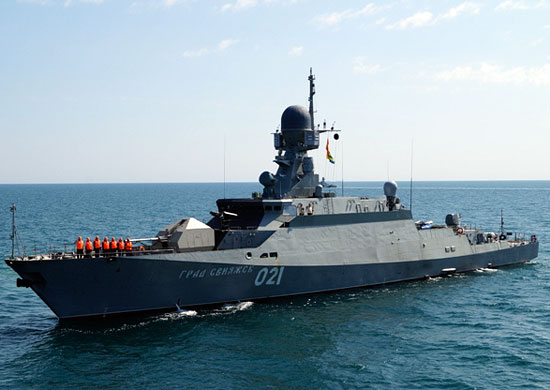In his State of the Nation speech today, Russian president Vladimir Putin showed computer animations and videos demonstrating three new classes of strategic weapons under development that are specifically intended to defeat the United States’ ballistic missile defenses. Among them were two weapons powered by miniaturized nuclear reactors: a drone submarine “torpedo” previously revealed in a Russian news leak and a cruise “missile” drone with what Putin described as a virtually unlimited range. The third was a new non-ballistic, hypersonic ICBM capable of evading US missile interceptors.
The weapons, Putin said, were a direct response to the US’s withdrawal from the Anti-Ballistic Missile Treaty and its continued development of ballistic missile defenses—which the Russian government has argued undermine the strategic deterrent value of Russia’s existing nuclear force. “No one has listened to us,” said Putin. “Listen to us now.”
A little something extra for the fallout

Putin claimed that the cruise missile’s miniaturized nuclear power plant had been successfully tested last fall and that, when built, the weapon would have a “practically unlimited” range. An animation showed a computer-generated image of the weapon flying close to the ground, following terrain contours, flying over mountains, and out to sea, avoiding seaborne air defense radars on its way to a virtual target. A similar animation showed nuclear-powered torpedoes launched from a submarine, traveling “intercontinental” distances, and striking a US aircraft carrier and exploding near a shore facility. This was the first official public announcement of both weapons.
#Putin: Missile defence useless against our new technologies https://t.co/2LBP29JBVV pic.twitter.com/GC4b9DD89B
— RT (@RT_com) March 1, 2018
Flying reactors have been attempted in the past, but for obvious reasons they’ve never been deployed—while it’s been demonstrated that a nuclear reactor could effectively power a turboprop or turbojet engine, the risk and cost of a flying nuclear aircraft are prohibitive, to say the least. Then there’s the weight of the reactor (plus shielding to protect crew from dying before getting to a target, in the case of nuclear aircraft) and the accompanying loss of payload capacity. Russia conducted airborne reactor tests in the 1960s with the Tupolev Tu-119 “Nuclear Flying Laboratory,” but abandoned development. The US tested airborne reactors and developed nuclear aircraft engines in the 1950s―including a nuclear ramjet engine for the Supersonic Low Altitude Missile (SLAM) that was tested on the ground but never flew.
Putin claimed the reactors used in the sub-drone and cruise missile were 1/100th of the size of current nuclear sub reactors. That’s still a fairly massive piece of hardware to put in a torpedo or cruise missile.
But wait, that’s not all
The third weapon, called Avangard, is a hypersonic maneuverable re-entry vehicle (MARV), described by Putin as being capable of high-speed radical evasive maneuvers while in flight and of delivering its warheads at over 20 times the speed of sound. It would strike, Putin said, “like a meteorite, like a fireball.”
The Avangard is probably what has previously been called “Objekt 4202,” also known as the YU-71, or the Aeroballistic Hypersonic Warhead. Unlike a traditional ICBM, the Avangard would get its boost from the new massive Sarmat ballistic missile and then skip along the top of the atmosphere under its own control at the edge of the Earth’s atmosphere and could maneuver around potential intercept points using its control surfaces as well as ramjet engines. It would be launched aboard a ballistic missile―the new Sarmat missile, now in testing, has enough range that it could be routed over the South Pole from Russia and strike targets in the US. A video for the Sarmat showed warheads from a missile launched on such a route falling over Florida—presumably targeting Mar-a-Lago.
Putin: #Sarmat system has virtually no range limit and will be able to attack across both the South and North Poles https://t.co/2OzZEAnh46 pic.twitter.com/C8AAhoJQr8
— RT (@RT_com) March 1, 2018
The Sarmat itself is near ready for deployment. The ICBM is part of Russia’s broad modernization of its nuclear forces, a modernization that hasn’t just focused on weapons capable of striking the US. And so is another weapon Putin mentioned, the “Dagger:” an air-launched, tactical, nuclear-capable weapon intended to strike targets such as US Navy aircraft carriers while flying at Mach 10 to evade air defense systems on accompanying Aegis destroyers.
Some of Russia’s modernization steps have skirted or potentially outright violated a different treaty with the US: the Intermediate-range Nuclear Forces (INF) Treaty signed by the Soviet Union and United States in 1987. Russia has built new nuclear-capable land-based cruise missile systems that the US argues are in violation of INF. And over the past five years, as part of its rapid modernization, the Russian Navy has expanded its strategic capabilities, including one that’s essentially a thumbing of the nose at the INF’s fine print.
In addition to new Borey-A ballistic missile submarines, Russia has built the Buyan-M class of “missile corvettes,” small ships that can carry nuclear cruise missiles. The Buyan-M is small enough that it is capable of launching missiles not just at sea, but inland from Russia’s rivers or the Moscow Canal system, allowing a dodge around the terms of the INF Treaty.

A Buyan-M class corvette.
According to a recent interview with Russian Navy chief Admiral Vladimir Korolev in the newspaper Krasnaya Zvezda (Red Star), there are five Borey-A ballistic missile submarines in various stages of construction right now, in addition to three that were built within the last five years. And six Yasen-class submarines capable of carrying up to 40 land-attack cruise missiles are also under construction.
The nuclear-powered cruise missile gap
The US government and the Department of Defense’s Missile Defense Agency have argued that the ballistic missile defenses the US has built in Europe (in the form of Aegis Ashore), at sea (aboard Aegis-equipped guided missile destroyers and cruisers), and at home (the Ground-based Midcourse Defense Defense (GMD) interceptor) are really focused on countries such as Iran and North Korea—and not Russia or China.
But both Russia and China have objected heavily to US missile defense programs as they’ve crept closer to their respective homelands. And Russia’s response, in a purely nuclear deterrence game theory way, is somewhat rational: if the US government felt that it could shoot down at least some inbound missiles from Russia, a certain US leader might become emboldened and believe that a nuclear war was winnable.
However, Russia’s nuclear cruise and torpedo weapons are, from an arms control standpoint, not exactly deterrent-focused weapons. They’re potentially first-strike weapons, capable of evading detection until the moment they strike. As fast as they are, they require long transit times and could be conceivably deployed in “loiter” mode, hanging out somewhere on station while simply awaiting a signal to strike.
As far as the Avangard goes, Russia is not alone. The US and China also have hypersonic weapons in development. China has been testing its Hypersonic Glide Vehicle since 2014, and the Chinese military has called it a “carrier killer” accurate enough to strike a ship at sea.
The US has focused on conventional (non-nuclear) hypersonic weapons. DARPA and Lockheed Martin had been developing the Falcon Hypersonic Technology Vehicle 2 (HTV-2), to meet the US Strategic Command’s desire for a “Prompt Global Strike” capability—a way for the US to hit targets anywhere in the world within one hour. That program ended in 2014, with no further development planned. An Army program, the Advanced Hypersonic Weapon, was more successful and is still in development.
Be the first to comment